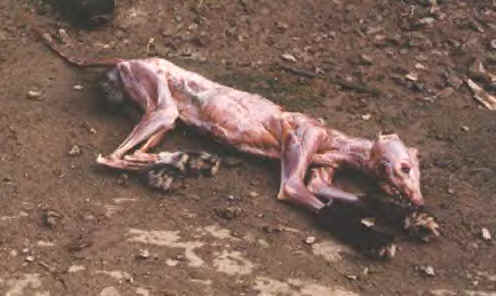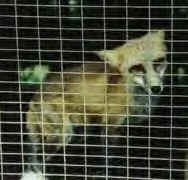|
Eighty-five percent of the fur industry’s skins come from animals living captive on fur factory farms.(1) These farms can hold thousands of animals, and the practices used to farm them is remarkably uniform around the globe. As with other intensive-confinement animal farms, the methods used on fur factory farms are designed to maximize profits, always at the expense of the animals. |
 |
Painful and Short Lives
The most farmed fur-bearing animal is the mink, followed by the fox. (above photo) Chinchillas, lynxes, and even hamsters are also farmed for their fur.(2) Sixty-four percent of fur farms are in Northern Europe, 11 percent are in North America, and the rest are dispersed throughout the world, in countries such as Argentina and Russia.(3) Mink farmers usually breed female minks once a year. There are about three or four surviving kits for each litter, and they are killed when they are about half a year old, depending on what country they are in, after the first hard freeze. Minks used for breeding are kept for four to five years.(4) The animals—housed in unbearably small cages—live with fear, stress, disease, parasites, and other physical and psychological hardships, all for the sake of a global industry that makes billions of dollars annually.
Rabbits are slaughtered by the millions for meat, particularly in China, Italy, and Spain. Once considered a mere byproduct of this consumption, the rabbit fur industry demands the thicker pelt of an older animal (meat rabbits are killed at the age of 10 to 12 weeks). The United Nations reports that “few skins are now retrieved from slaughterhouses,” and countries such as France are killing as many as 70 million rabbits a year for fur, used in clothing, as lures in flyfishing, and for trim on craft items.(5)
Life on the “Ranch”
To cut costs, fur farmers pack animals into small cages, preventing
them from taking more than a few steps back and forth. This crowding and
confinement is especially distressing to minks—solitary animals who may
occupy as much as 2,500 acres of wetland habitat in the wild.(6) The anguish
of life in a cage leads minks to self-mutilate—biting at their skin, tails,
and feet—and frantically pace and circle endlessly. Zoologists at Oxford
University who studied captive minks found that despite generations of being
bred for fur, minks have not been domesticated and suffer greatly in
captivity, especially if they are not given the opportunity to swim.(7) Foxes,
raccoons, and other animals suffer equally and have been found to cannibalize
each other as a reaction to their crowded confinement.
Animals on fur factory farms are fed meat byproducts considered unfit for human consumption. Water is provided by a nipple system which often freezes in the winter or may fail because of human error.
| Pests and Parasites Animals on fur factory farms are more susceptible to diseases than their free-roaming counterparts. Contagious diseases such as pneumonia are passed from cage to cage rapidly, as are fleas, ticks, lice, and mites. And disease-carrying flies thrive in the piles of rotting wastes that collect under the cages for months. Video footage and photos taken by undercover investigators show animals suffering from severe infections and injuries, untreated and left to die slowly. |
 |
Unnatural Habitats
Fur factory farm cages are often kept in open sheds that provide little to no
protection from wind or harsh weather. Their fur alone is not enough to keep
them warm in the winter, and in the summer, minks swelter because they have no
water in which to cool themselves. When minks learn to shower themselves by
pressing on their drinking water supply nipples, farmers will modify the
nipples to cut off even this meager relief.
Poison and Pain
No federal humane slaughter law protects animals on fur factory
farms, and killing methods are gruesome. Because fur farmers care only about
preserving the quality of the fur, they use slaughter methods that keep the
pelts intact but which can result in extreme suffering for the animals. Small
animals may be crammed into boxes and poisoned with hot, unfiltered engine
exhaust from a truck. Engine exhaust is not always lethal, and some animals
wake up while being skinned. Larger animals have clamps or a rod applied to
their mouths while rods are inserted into their anuses, and they are painfully
electrocuted. Other animals are poisoned with strychnine, which suffocates
them by paralyzing their muscles in painful rigid cramps. Gassing,
decompression chambers, and neck-snapping are other common fur-farm slaughter
methods.
The fur industry refuses to condemn even blatantly cruel killing methods. Genital electrocution, deemed “unacceptable” by the American Veterinary Medical Association (AVMA) 1993 Panel on Euthanasia, is a fur factory farm killing method that causes animals the pain of cardiac arrest while they are fully conscious. In 1994, Indiana became the first state to file criminal charges against a fur factory farm after investigators documented genital electrocution at V-R Chinchillas. The chinchilla fur industry considers electrocution and neck-breaking “acceptable.”(8)
In 1995, one district attorney filed charges against pelt supplier Frank Parsons of Salisbury, Md., for injecting a mixture of rubbing alcohol and weed-killer into the chests of minks. Undercover investigators videotaped Parsons using an illegal pesticide, Blackleaf 40, to painfully kill the minks.
Would You Wear Your Dog?
An undercover investigation by the Humane Society of the United
States, reported in a 1998 Dateline NBC piece, revealed that dog and cat fur
is a multimillion-dollar industry in Asia and found that coats and toys made
with domestic dog fur are being sold in the U.S. “There are no federal laws
preventing anyone from importing dog and cat fur into this country,”
reported Dateline. “If the imported item costs less than $150, the importer
doesn’t even have to reveal what it’s made of.” Dateline footage shows a
German shepherd, tail wagging and head stuck in a restraint, moments before he
is skinned alive. A cat, crowded in a cage, watches and waits his turn, as one
by one, his cagemates are choked, slung up, and hanged just inches away.(9)
New legislation outlawed the import or sale of clothing containing dog or cat
fur, but the fur still enters the country illegally since it is intentionally
mislabeled and can only be detected by expensive DNA testing.
Environmental Destruction
Contrary to fur-industry propaganda, fur production destroys the
environment. The energy needed to produce a real fur coat from ranch-raised
animal skins is approximately 20 times that needed for a fake fur.(10) Nor
does fur biodegrade, thanks to the chemical treatment applied to stop the fur
from rotting. The process of using these chemicals is also dangerous as it can
cause water contamination.
About 44 pounds of feces are excreted per mink skinned by fur farmers. Based on the total number of minks skinned in the U.S. in 1999, which was 2.81 million, mink factory farms generate approximately 62,000 tons of manure per year. One result is nearly 1,000 tons of phosphorus, which wreaks havoc in water ecosystems.(11)
Fur in Sheep’s Clothing
As fur sales decline, sales of shearling—the skin of lambs with the
wool attached—have risen. Some fur manufacturers have actually taken to
disguising mink as shearling.(12) Many people are unaware of shearling’s
origins or that shearling sales are an incentive for sheep ranchers to
increase their stock, thereby adding to the plight of sheep.
In Afghanistan, karakul sheep are now raised to produce lambs for the high-end
market in “Persian lamb” coats and hats. For “top-quality” lamb skin,
the mother is killed just before giving birth and her fetus is cut out. The
pelts of the unborn lambs are prized in the fashion world for their silk-like
sheen. It takes the skin from an entire lamb to make one karakul hat.(13)
Industry in Decline
Austria and the U.K. have banned fur factory farms, and the
Netherlands began phasing out fox and chinchilla farming in April 1998.(14) In
the U.S., there are approximately 324 mink farms left, down from 1,027 in
1988.(15) In a sign of the times, supermodel Naomi Campbell was denied entry
to a trendy New York club because she was wearing fur. Said the club’s
owner, “I really love animals, and I wanted us to be the good guys.”(16)
Humane Choices
Consumers need to know that every fur coat, lining, or item of trim
represents the intense suffering of several dozen animals, whether they were
trapped, ranched, or even unborn. These cruelties will end only when the
public refuses to buy or wear fur. Those who learn the facts about fur must
help educate others, for the animals’ sake. For more information, visit
FurIsDead.com.
References
1.“Facts on Furs,” International Fur Trade Federation, 2000.
2.“To Make 1 of These … You Need 183 of These,” E.S. Magazine,
27 Oct. 2000.
3.“Fur Farming,” International Fur Trade Federation, 2000.
4. “General Livestock,” The Digital Daily, Department of the
Treasury.
5. Food and Agriculture Organization of the United Nations, The Rabbit:
Husbandry, Health and Production, No. 21 (Rome: 1997).
6. “Minks,”
7. “What Captive Minks Miss Most—Swimming,” Reuters, 28 Feb. 2001.
8. “Standard Guidelines for the Operation of Chinchilla Ranches,” Ontario
Ministry of Agriculture and Food, Mar. 1998.
9. Dateline NBC, 15 Dec. 1998.
10. Gregory H. Smith, “Energy Study of Real vs. Synthetic Furs,”
University of Michigan, Sep. 1979.
11. S.J. Bursian, G.M. Hill, R.R. Mitchell, and A.C. Napolitano, “The Use of
Phytase as a Feed Supplement to Enhance Utilization and Reduce Excretion of
Phosphorous in Mink,” 2003 Fur Rancher Blue Book of Fur Farming,
Department of Animal Science, Michigan State University.
12. Joan Verdon, “The Golden Fleece,” Hackensack Record, 21 Sep.
2002.
13. Paul Haven, “Karzai’s Hat Made From Lamb Fetus,” Associated Press,
23 Apr. 2002.
14. Eurogroup for Animal Welfare, “Commission Report Reveals Serious Welfare
Problems in Fur Farming,” 20 Dec. 2001.
15. Sandy Parker, Sandy Parker Reports: Weekly International Fur News,
13 Oct. 2003.
16.“Fur Flies Out of Fashion,” MX, 13 Sep. 2002, p. 30.
"The thinking man must oppose all cruel
customs no matter how deeply rooted in tradition or surrounded by a halo he
may be . . . We need a boundless ethic which includes the animals as
well."
- Dr. Albert Schweitzer (1875-1965)
Return to Biblical Vegetarianism index
The
Nazarene Way of Essenic Studies
Email us at: Comments@TheNazareneWay.com
Join our Essene
Holy Communions email list
Sign
our Guest Book